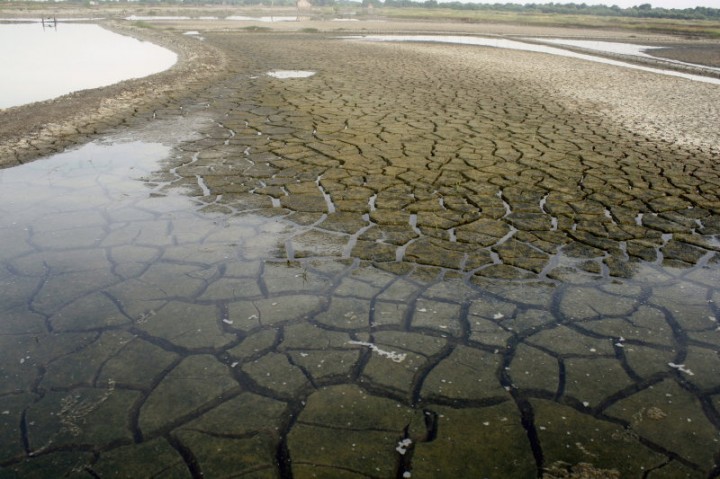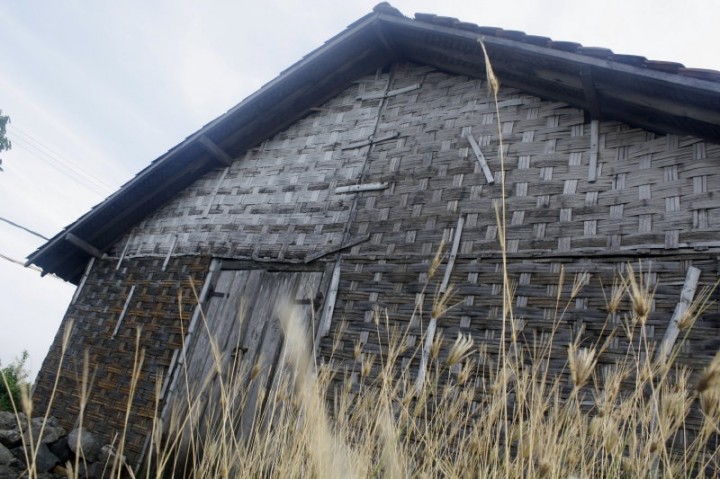
That morning salt fields along Benowo-Osowilangun seemed deserted. Dead. Cracked soils gaping. Marks of long period untouched by seawater. In some parts, puddles of dirty rain water. The pipes used to channel sea water from wells lie around wasted and broken, no longer in use. Siwur, windmills, and huge rollers lying around.
Amidst the grooves of the embankment, huts from woven bamboo, rickety shacks in the brink of collapse. Long uninhabited. Now, no longer do salt farmers come here to work. It used to be that salt fields were already crowded by workers in April. Further development however leads to the decline of salt farms, replaced by residential areas, factories, industrial areas, malls, shops and highways.
“Hopefully they’ll come soon. It might be due to the rain,” said Supar, a man who had become the supervisor of about 50 hectares of salt farms at the border Gresik-Surabaya. Misplaced rain, or climate change, is taken as the reason, but is it really?
The labour of salt farmers
In the early 1980s, along Surabaya-Gresik-Lamongan unbroken chains of salt fields greeted people on the left and right sides of the road. In those days, salt farming seemed like a promising work. As time passed, salt farms declined, replaced by residential areas, factories, industrial areas, malls and shops, as well as toll roads.
Now leaving only approximately 50 ha of salt fields, in between the development of a spectacular sport stadium, Bung Tomo, and the problem-infested Benowo landfill.

In its heyday, farmers are able to produce up to 50 kg of salt per day per hectare from the fields they till, even more during the dry season. Unfortunately, the salts produced are often purchased at a very low price. Once the price even dropped to IDR4 per kg. Meaning, a day’s work was only priced at IDR200. The reason? Supposedly, because the quality of the salt produced was very low.
According to the Indonesian National Standards Institute (LSNI), salt produced must at least meet 13 quality standards. Such as, Iodine content should be between 30-80 ppm, clean, white in color, odorless, low humidity levels, not contaminated by heavy metals, and the NaCl content should be more than 95%.
If the above standards are not met, the salt will be purchased at a very, very low price. The government prefers to import salt from India and Australia that meet standard quality to improving the quality of Indonesian salt. This paradigm ultimately kills off the production people’s salt.
This despite the fact that demands for salt in Indonesia keep increasing. Just last year demand for national salt has increased up to 2.86 million tonnes. While the production of local salt is only up to 24 thousand tonnes. The remaining demand is then supplied by salt industries and largely through import.
Such an irony considering Indonesia is supposedly a maritime country. Seawater as the main resource is readily available, everywhere in Indonesia. Yet local salt farms continue to decline in quantity and quality. For example, in 2001 there were 256.000 ha of salt farms, along the northern coast Pantura, Cirebon and Indramanyu, NTB and Bali. Now it’s less than half it used to be.

Cracked soils gaping. Marks of long period untouched by seawater. In some parts, puddles of dirty rain water.
The number of salt farmers in Madura in early 2000s was over 100,000, but now, it’s less than a thousand people. Many ex salt farmers in TKI now prefer to be migrant workers, others migrate to Java as scavengers and pedicab drivers. They stated mostly the same reasons, salt farming is an unprofitable about, almost like a forced, exploited labor.
Worse yet, salts produced in farms are hardly valued, whereas iodized salt by manufacturers are priced relatively high. For example 10 kg of iodized salt is priced at IDR20,000, while one kg of salts of the best quality produced by salt farmers is only priced at IDR800, generally even less, at around IDR500 per kg.
Prof Soetandyo WignyoSoebroto, an Airlangga University professor who has done researches on salt farmers, mentioned that there are three issues facing salt farmers: weather, landowner’s honesty, and the instability of salt prices. In fact, the volatile prices of salts trigger most salt farmers to resign from his job.
It’s no secret that the salt farmers in Benowo are mostly farmers who’ve been knocked out from their jobs in Madura. Generally they come from poor villages around Sumenep, such as the Village Kertasada, Merengan, Skirting Papas, and Kali Mojo.
According to Zaini, a penggaram already over twenty years to his work, since it was built in Kalianget by PT Garam, the small traditional salt makers have been eliminated. They were forced to seek other means for work, including to Gresik and Surabaya.

Amidst the grooves of the embankment, huts from woven bamboo, rickety shacks in the brink of collapse. Long uninhabited. No more salt farmers come here to work. Now, no longer do salt farmers come here.
To meet the needs of daily life, land owner will lend them money between Rp 75,000 to Rp 100,000 per week. Once harvest comes, they would cut wages from this loan. “I used to be able to get one and a half million after six months of work here. The money can be used as capital live in the village. Now, even getting a million can be difficult,” said Mat Sanir bitterly, particularly with increasingly rising living needs.
Good and honest landowner does not only lend money, but also buy salts to match the market price. Unfortunately, there are bosses who buy cheap salt when they’re expensive. Someone cut the loan plus interest. It’s not money earned, but debt.
Sometimes landowners too are faced with the harsh reality, when salt prices fall very low. He’d be lost how much he should pay his labor force. Salts are then stockpiled in warehouses, waiting for prices to improve. Government has a very significant role in determining the price. Indonesian salt farmers are impoverished by an unhelpful system made by the government.
Lately though, demand for salt cultivated by people—not factories—have increased in cosmetic industry. Hand-cultivated salt becomes the main ingredients in scrub, skin mask, sold at high prices. 200g scrub can fetch a price up to IDR20-50,000. The main ingredient, salt, is only priced at IDR800 per kg. Salt from Bali lately has also been exported to the United States, to be sold at 10USD per 300gram. So, if only salt from these farms can also be used for cosmetic industry. Perhaps that’d be a good incentive to generate income? Ahahahaha!
This post is also available in: Indonesian



